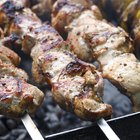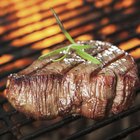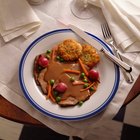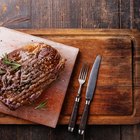Although lamb in general is tender meat, some cuts are tougher and will benefit from long, slow cooking. Shanks are the most common example, but the shoulder is also best when slow-cooked. It's usually cut for low-cost lamb chops, but most butchers will happily sell you a shoulder roast, either boneless or bone-in, if you call ahead. A bone-in shoulder is moister and richer in flavor but complicated to carve, so most recipes call for a boneless rolled shoulder. They can be roasted as-is, or stuffed.
Check your roast to ensure that it's tightly rolled. A tightly rolled shoulder cooks more evenly than a loosely tied roast. If necessary, re-tie the roast yourself with cotton kitchen twine.
Wipe the surface with paper towels to dry it and remove any loose fragments of fat or bone left by the butcher. Trim the outer layer of protective fat to make its depth uniform, but don't cut it away. You'll need it to keep the lamb moist during cooking.
Score the fat lightly with your knife blade, taking care not to cut into the meat. Sear the meat in a hot skillet until well browned on all sides. Move the lamb to your cutting board.
Mash the minced garlic with the side of your knife until it becomes paste, and spread it over the entire roast. Season liberally with salt and pepper, or any other combination of flavors that appeals to you.
Transfer the shoulder to the rack of your roasting pan, and place it in a preheated oven at 325 F. Slow-roast until the internal temperature reads 140 degrees on a meat thermometer, usually 2 to 3 hours for a small shoulder.
Remove the lamb from your oven and let it rest under a loose cover of aluminum foil for 15 to 20 minutes before carving.
Related Articles
How to Cook a Lamb Square Cut Shoulder

How to Cook a Deer Neck Roast in a Slow ...

How to Cook a Tender Lamb Breast

How to Cook Boned Rolled Shoulder of ...
How to Convection Cook a Pork Shoulder ...

How to Cook Venison Shoulder Roast in a ...
How to Cook Buffalo Fillet

How to Bake a Pork Loin Center Half

What Is the Safe Cooking Temp for a ...

How to Cook a 15-Pound Rib Roast

How to Bake a Dry Rubbed Corned Beef ...
How to Cook Boneless Lamb Butterflied ...

How to Grill a Whole Filet Mignon

How to Cook a Deer Brisket

How to Cook a Beef Topside Roast
How to Cook a Seven Bone Pot Roast in ...

How to Prepare Chuck Tender Roast

How to Cut Up Your Deer Tenderloins

How to Cook Tender Rolled Flank Steaks ...

How to Slow Roast an Angus Roast
References
Tips
- Lamb is cherished in many culinary cultures, so the basic recipe can be easily adapted to a different cuisine by changing the seasoning.
Writer Bio
Fred Decker is a trained chef and prolific freelance writer. In previous careers, he sold insurance and mutual funds, and was a longtime retailer. He was educated at Memorial University of Newfoundland and the Northern Alberta Institute of Technology. His articles have appeared on numerous home and garden sites including GoneOutdoors, TheNest and eHow.